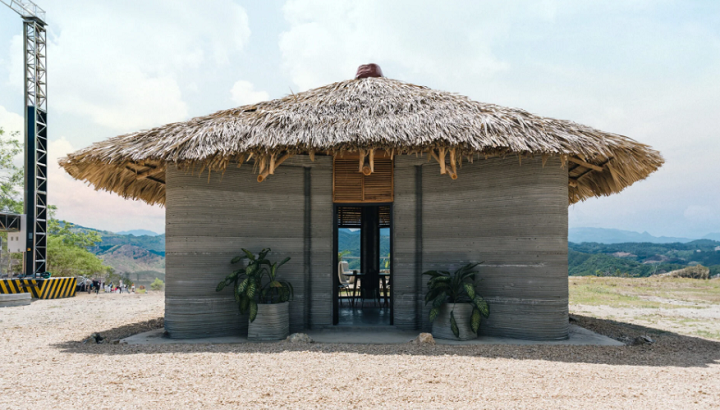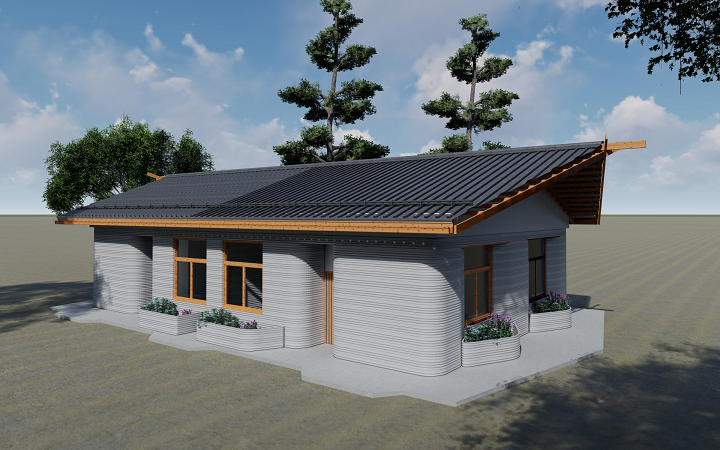3D Printing News Briefs, November 25, 2023: Housing, Seed Funding, & More
We’re starting with additive construction news in this Thanksgiving weekend edition of 3D Printing News Briefs, and then moving on to seed funding and a Memorandum of Understanding. Finally, we’ll end with Desktop Metal’s latest releases.
First 3D Printed Building in Guatemala Inaugurated

The entry to the first 3D printed house in Guatemala, which combines a modern building technique and curved walls with a traditional palm leaf rancho-roof type, ideal for seismic conditions.
The first 3D printed building in Guatemala has been inaugurated through Central and South American cement company Progreso’s corporate accelerator. Danish 3DCP Group and COBOD International, using the BOD2 construction 3D printer, achieved another milestone—the 49 m2 house, which was 3D printed in 26 hours over seven days and features three-meter high walls, has taken major steps to verify the structural integrity of additive construction (AC) in a region prone to seismic activity. 3D printing enabled the organic shape of the house, which couldn’t be achieved with concrete blocks, but the rancho-roof features traditional palm leaves, which are inexpensive and offer thermal comfort; plus, due to their light weight and flexibility, they are also ideal for seismic regions.
“With immense satisfaction, we completed this unique project using 3D printing technology, once deemed distant. Progreso’s enduring spirit of innovation led us to explore new methods, culminating in a collaboratively designed building featuring a sustainable “rancho” roof, ensuring natural cooling in seismic regions,” said Plinio Estuardo Herrera, Manager of Concrete R&D at Progreso. “This achievement, a testament to our teamwork, harmoniously blends advanced technology with local traditions, thanks to the unwavering support of 3DCP Group and COBOD.”
3D Printed Transitional Housing for Indigenous Canadians

The Blackfoot design incorporates wood beams that project like tipi poles. Interior spaces in the bedrooms were made to accommodate sacred bundles. (Rendering provided)
Continuing with AC, the technology is also being used to build transitional housing for the Siksika Nation in Alberta, funded at $2.6 million from Indigenous Services Canada. Kakatoosoyiists (Star Lodges) will be the province’s largest 3D concrete printed housing project, and is the result of a partnership between Siksika Housing on the southern Alberta First Nation, Ontario-based AC company nidus3D, and the University of Calgary School of Architecture and Planning. There will be 16 transitional units, grouped in fourplexes, and each one will be about 600 square feet, with one bedroom and one bathroom, and could be occupied anywhere from six months to two years. They are meant for Nation members who are dealing with a housing crisis. The robotic arm printer operates onsite, laying concrete exterior walls on top of conventional interior walls, and can print the walls for one building in about a week. Ryan Hall, housing manager of Siksika Housing, considers this a pilot project, and hopes that if it’s successful, the Nation might consider purchasing a 3D printer to create housing, which would allow them to incorporate Blackfoot knowledge into the design. Other Indigenous communities in Alberta are also showing interest.
Hall explained, “I’ve been thinking about using the technology to build housing out here and it sort of went from there and to putting together a proposal and getting funding and then ultimately starting to build the project.
“We’re still trying to figure out some supply chain issues to acquire materials, but I think in the new year, they’ll be ready. Our contract requires that they are done by March 31.”
Phasio Lands $2.5M to Accelerate the Manufacturing Industry
Manufacturing-tech startup Phasio, founded in 2021, is a leading end-to-end manufacturing interface, and just received $2.5 million in seed funding to boost local manufacturing around the globe. The interface has tools designed to address areas of friction between customers and manufacturers, and intuitively streamline product development through features such as instant quotations, design collaboration, and managing personalized order experiences. Phasio also developed an AI agent for its interface, ManufacturingGPT (mGPT), that can quickly answer customer questions about specific manufacturing processes to simplify the order management workflow, and its platform includes several integrations across the manufacturing workflow, from CAD and accounting software to shipping providers. The strategic funding, led by Airtree Ventures with participation from 500 Global, Entrepreneur First and Michael Sorkin’s Gattaca Ventures, will allow the company to speed up its go-to-market strategy, first by scaling its engineering team to support increased demand, and then adding feature improvements to the interface, such as further developing mGPT’s AI capabilities.
“Our manufacturing interface is not just a tool; it’s a carefully designed ecosystem rooted in a deep understanding of the challenges that both manufacturers and customers face,” said Sudharshan Raman, CPO and Co-Founder of Phasio. “Phasio’s intuitive by design, removing barriers and making it easier for manufacturers to focus on what they do best: creating quality products.”
Axial3D & GE HealthCare Sign MoU for Personalized Orthopedic 3D Printing
Irish company Axial3D, a leader in medical segmentation and 3D solutions, is collaborating with GE HealthCare to enable personalized, MRI-based orthopedic 3D printing. In a big step forward for medical imaging and visualization, the two have signed a non-binding Memorandum of Understanding that aims to close the gap between MRI images and 3D patient-specific outputs. 3D printing for orthopedic applications typically uses CT imaging, which exposes patients to ionizing radiation. The goal here is to give healthcare professionals more insights into patient anatomy, without causing the patient further harm, by combining Axial3D’s FDA-cleared imaging segmentation platform with GE HealthCare’s unique MRI-based oZTEo bone imaging application. This will allow clinicians to achieve radiation-free 3D visualizations, which could lead to more precise diagnoses and 3D printed patient-specific anatomical models, and even reduce the amount of time patients and surgeons are in the operating room.
“We are thrilled to collaborate with Axial3D to bring this innovative solution to healthcare providers. This collaboration reinforces our dedication to improving patient care by providing radiation-free, MRI-based solutions for orthopedic imaging. Our oZTEo imaging application augments the traditional soft tissue detail of MRI with bone information, from which healthcare providers can generate 3D digital or physical models that aid in surgical planning and patient education,” said Anja Brau, PhD, GM, MR Clinical Solutions & Research Collaborations for GE HealthCare.
Desktop Metal Launches Industrial ETEC Pro XL Polymer 3D Printer

Now available below $40,000, the ETEC Pro XL premium polymer 3D printer delivers extreme accuracy, resolution, and surface finish in a large build area with the high throughput speeds for which area-wide DLP technology is known.
Additive Manufacturing 2.0 leader Desktop Metal recently announced the launch of its ETEC Pro XL premium polymer 3D printer—an industrial DLP system that, at less than $40,000, costs less than half the price of its predecessor, the classic EnvisionTEC Perfactory. With a build area of 249.1 x 140.1 x 165.1 mm, the ETEC Pro XL is currently qualified for use with E-Rigid Form Charcoal, HTM 140, and Easy Cast 2.0; upon request, the system is also backwards-compatible with materials previously approved for prior models of the P4K and Perfactory. This makes it great for multiple jewelry, medical, and industrial applications, like automotive parts, microfluidic devices, castable jewelry patterns, prosthetics, and more. It also features several high-value updates, including a premium 385 nm wavelength light engine, HyperPrint technology that makes DLP print times even faster with closed-loop sensing and a resin heater, a 4K ultra high-definition projector powered by an industrial DLP chip, and more. Plus, it’s Additive Manufacturing 2.0-enabled, which means customers can easily move from prototyping to full production on the same system.
“Our ETEC polymer brand has been a leader for 20+ years in high-quality DLP printing, and the ETC Pro XL continues that legacy at an accessible new price point while delivering critical user upgrades. DLP remains a superior polymer 3D printing technology for speed, surface finish, and accuracy, which is why we have more than 300 Super Fleet customers around the world with more than three systems running around-the-clock production with our machines. That includes manufacturers of industrial goods, toys, jewelry, medical devices, and consumer electronics,” said Founder and CEO Ric Fulop. “Our average customer fleet size is six printers, but it is not uncommon for our customers to have fleets of more than 20 printers. The platform on which the ETEC Pro XL is based, originally known as the Perfactory and more recently known as the P4K, has been a major driver of these Super Fleets.”
Desktop Metal’s New Live Monitor Software Application

Desktop Metal is launching Live Monitor, an Industry 4.0 solution for users of select Desktop Metal printers and ancillary equipment to monitor and use real-time data from their equipment to improve efficiency.
Desktop Metal also announced the launch of its Live Monitor software application, an Additive Manufacturing 2.0 solution for users of its Studio, Shop, and Production System printers and ancillary equipment. Live Monitor is an optional add-on feature in the company’s Live Suite package of exclusive software offerings, and provides easy access to useful, real-time 3D printing system data. With its helpful dashboards, it allows users to monitor their equipment in order to improve efficiency and management of their 3D printers, and real-time information includes key metrics like time reporting, consumable usage, and job and event status. Italy-based Desktop Metal subsidiary Aidro, a leader in volume production of next-generation hydraulic and fluid power systems using both traditional and additive manufacturing, has been a beta tester of Live Monitor for the past year, using the software for its Desktop Metal Shop System and Furnace
“Live Monitor is an essential tool for keeping the most important process variables under control and giving customers with critical parts, such as those in the energy industry, visibility and traceability of AM part production. The variables are visible, customizable, and recordable and this is the basis for having a qualified process. Thanks also to this tool, DNV has awarded Aidro AM manufacturer certification in accordance with the DNV-ST-B203 standard,” said Valeria Tirelli, President and CEO of Aidro. “Compared to other systems, Live Monitor can be customized in a simple and efficient way depending on the specific needs of the user.”
In the future, Live Monitor will be rolled out to users of other Desktop Metal and Team DM equipment sold under the ExOne, ETEC, and Desktop Health brands.
Subscribe to Our Email Newsletter
Stay up-to-date on all the latest news from the 3D printing industry and receive information and offers from third party vendors.
Print Services
You May Also Like
New Business: Temporary, Migratory, & Modular 3D Printed Architecture
If we look at potentially emerging 3D printing businesses, then architecture has not been fully explored. Yes, there is a lot of house 3D printing going on worldwide. From deployable...
3D Printing News Briefs, April 19, 2025: Material Extrusion Standard, Metal Powder, & More
In today’s 3D Printing News Briefs, we’re covering a proposed standard for material extrusion, before moving on to business and metal powder. We’ll end with a commercial store’s robotic 3D...
Japan Unveils World’s First 3D Printed Train Station
Japan is now home to what we believe is the world’s first train station built with 3D printing technology. Located in Arida City, just south of Osaka, the new Hatsushima...
restor3d Raises $38M to Expand 3D Printed Orthopedic Implants
Backed by $38 million in new funding, restor3d is pushing ahead with the launch of four personalized implant lines, set to roll out in 2025 and 2026. This latest venture...



























